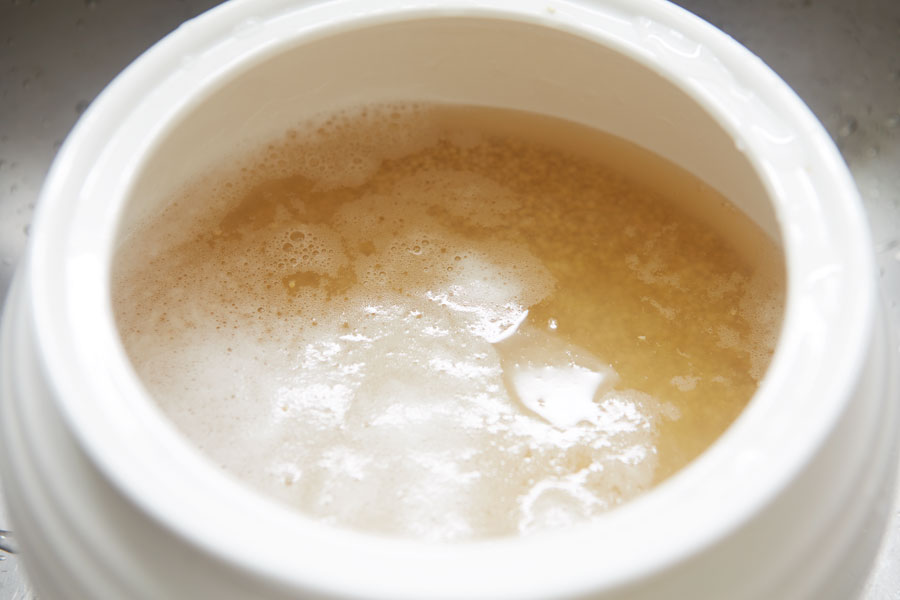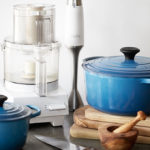
Pour a little fresh olive oil over the top, dust with flaky sea salt and pepper. Have a warm nourishing bowl all on its own, or beside protein and veggies.
Make a big batch of this simple savory recipe
Use it as a base for meal variations throughout the week. It’s delicious on it’s own, but it’s even better with steamed florets of cauliflower, or sautéed mushrooms, or mixed in with brisket and curry!
The combinations are infinite
The important thing is that once you make this base, you’ll quickly be able to dress it up and create complete dishes throughout your busy week. This recipe yields enough quinoa for two people served as a side dish for an entire week of meals. Reduce all ingredients equally for a smaller batch.
Before You Get Cooking
Ferment your quinoa. Place dry quinoa in a large bowl and cover with water, about 1 inch above grains. Add a tablespoon of vinegar. Stir. Cover. Soak overnight, or at least 6 hours at room temperature, around 70 F or warmer. The next day you’ll find foam floating on top. Pour these impurities off. Rinse the quinoa in a mesh strainer. If you’re not ready to cook, soak the quinoa for a second day with fresh water and vinegar, or just drain and store in the fridge. Read below for the details on why this step should become a regular part of your grain cooking routine.
Store
Use glass containers for storage. Let the dish cool sufficiently before placing the plastic lid on to avoid too much condensation. You’ll still find some condensation the next day. Remove the lid slowly so the droplets don’t release. Rinse off, dry and replace. Once the dish is completely cold you won’t get much condensation again.
You could try these beauties, but Weck jars are not only more of an investment, but I also find the clips a bit dangerous for spills and hard to keep track of.

Pile of delicious leeks on the left. Right, simmering the quinoa together with all the ingredients in the pot.
SOAKING GRAINS IS AN EASY AND VITAL STEP FOR GOOD HEALTH
All grains, nuts and seeds contain a series of anti-nutrients which act as natural pesticides, sprouting inhibitors and other essential factors for the health of the plant. Unfortunately when consumed by humans, unlike the multi-chamber stomachs of ruminants, the acids in our guts are not strong enough to brake those chemicals down effectively.
AS A RESULT THE PHYTIC ACID, TANNINS, GLUTEN-RELATED PROTEINS AND ENZYME-INHIBITORS IN UNSOAKED GRAINS WILL:
- bind with essential minerals in the gut, flushing them from your body
- block new mineral absorption
- irritate the gut
- inhibit digestion
- lead to bone loss
- cause allergies
- put stress on the pancreas
Altogether these effects can lead health problems — but can be prevented with one simple step.
During the soaking process the acids in vinegar or lemon juice help to eliminate anti-nutrient compounds while allowing the plant to sprout. The sprouted seed released from dormancy becomes a live food once again. Nuetralizing the seed-preserving compounds allows for the body to stay mineralized while being further fortified with essential minerals (meaning that your body cannot produce them) otherwise locked into the grain. Bio-available vitamin content increases, “tannins, complex-sugars, gluten and other difficult-to-digest substances are partially broken down into simpler components that are more readily available for absorption.” (source)
As you can see, this process is non-negotiable if you’d like to improve or maintain good health. The bonus is that your cooking times will be drastically reduced. By about half for most grains!
I’ll admit that I don’t soak and sprout my nuts and seeds. You really need a dehydrator for that, and due to considerations of space, time and energy, I’ve decided to let that slide. My diet contains a very small fraction of nuts and seeds compared to how much, and how often, grains play a role in my diet. This feels good to me–and it ends up saving me time!
TIPS FOR GOOD HEALTH AND EASE
- Soak for a minimum of 6 hours, but you can leave the grains in the same water for about 24 hours.
- If you’re not ready to cook when 24 hours is up, simply refill with fresh water and vinegar.
- Soak in a dark warm place, like a cupboard or oven (while turned off).
- Pour off the soaking liquid before cooking and rinse the grains at least once.
- For extra pure grains: pour off soaking liquid, add fresh water, stir well and let any bubbles or foam rise, pour water off. Repeat until all the impurities have been released and the water is clear.
- Soaked grains absorb water, decreasing cooking time and grain to water ratios. Once you’ve made soaked grains a few times you’ll get a better sense of water ratios and will know when to add less, or more.
- Store dry grains in a glass container with a tight lid, away from direct sunlight to prevent rancidity of the fragile oils contained in the seeds.





